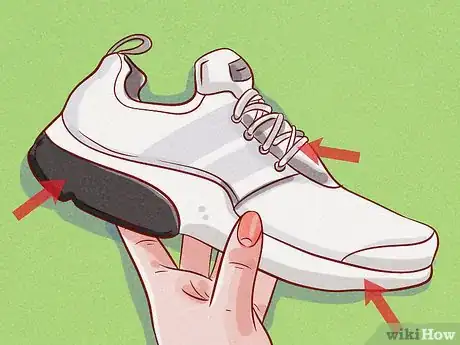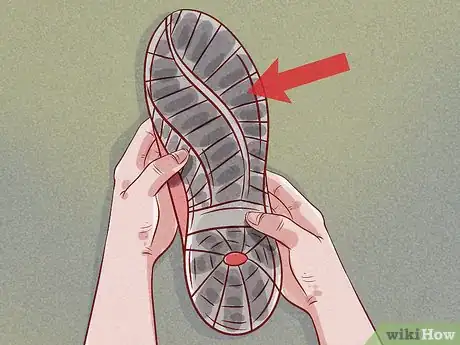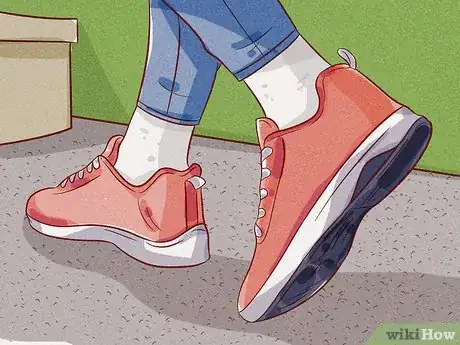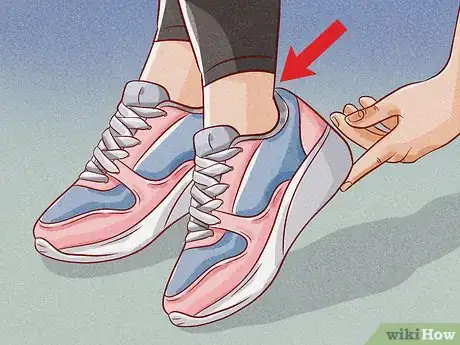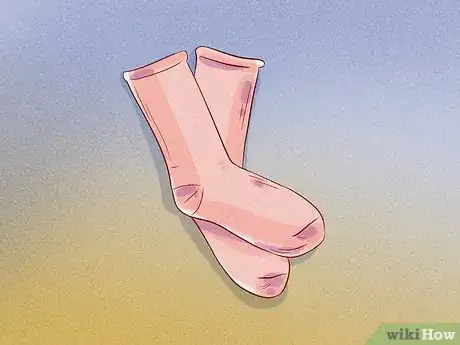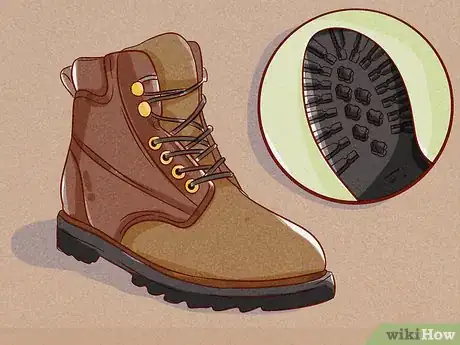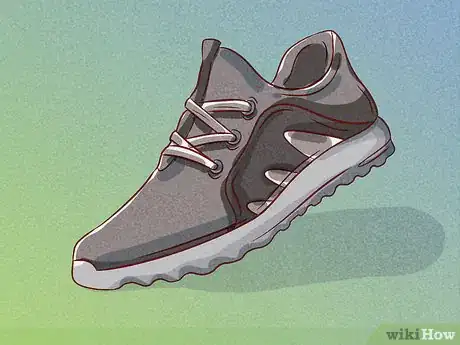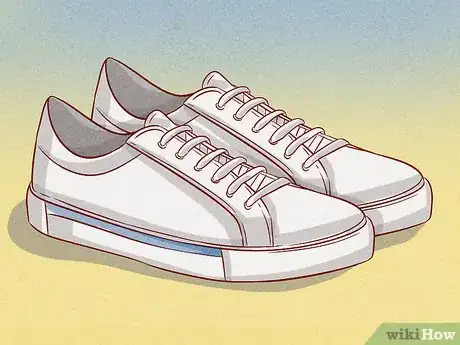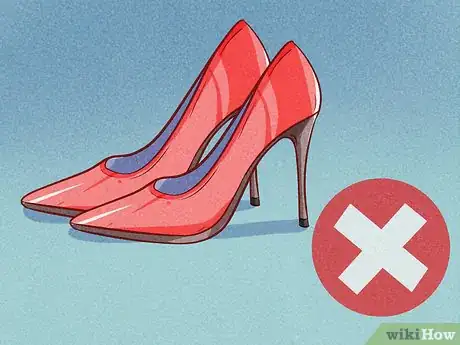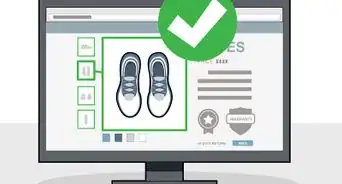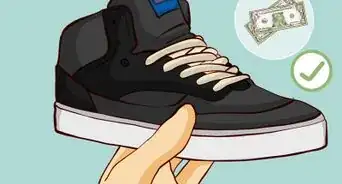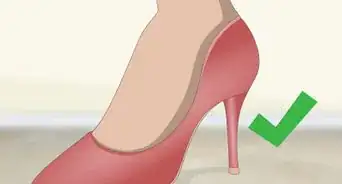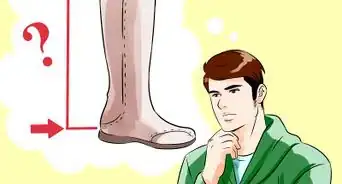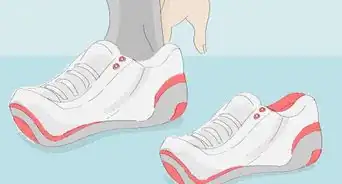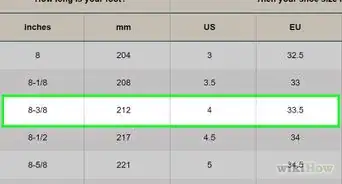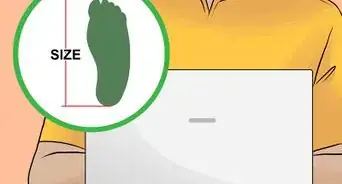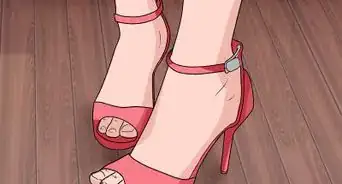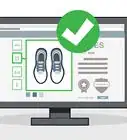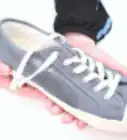This article was co-authored by Joanne Gruber and by wikiHow staff writer, Amy Bobinger. Joanne Gruber is the owner of The Closet Stylist, a personal style service combining wardrobe editing with organization. She has worked in the fashion and style industries for over 10 years.
There are 12 references cited in this article, which can be found at the bottom of the page.
This article has been viewed 115,525 times.
Picking the right shoes can be difficult. First, you have to find a pair that fits comfortably when you’re shopping. Then, when you’re getting dressed, you have to find the shoes that are the best suited for wherever you’re going, and they still need to look nice with your outfit. Luckily, there are a few tips that can make it easy to choose the perfect shoes, no matter where you’re going!
Steps
Trying on Shoes
-
1Examine the construction of the shoe before you buy it. Check the materials the shoe is made of, including the top part of the shoe, called the upper, along with the sole, insole, tongue, and any eyelets or laces. Pay attention to whether the seams feel secure and all of the materials feel durable.[1]
- If the shoe seems flimsy, it’s not likely to last long, and it could change the way the shoe fits if it starts to unravel.
-
2Make sure the sole will protect you if you step on anything sharp. The primary purpose of your shoes is to protect your feet. If you wear a shoe with a thin, flimsy sole, and you step on something sharp like a tack or a nail, you could be seriously injured. Make sure the sole is thick enough and sturdy enough to keep anything from penetrating all the way through to your foot.[2]
- If the sole of the shoe is stitched to the upper, rather than glued, it’s a sign that the shoe is very high-quality.
- If you'll be spending time around a construction site or somewhere that's likely to contain a lot of sharp objects, opt for a hard-soled shoe.
Advertisement -
3Walk around in the store to test the fit when you try on shoes. Sit on the bench and wiggle your toes around to make sure the shoes aren’t too small, but don’t stop there. Walk from one end of the store to the other, paying attention to whether the shoes slip off your heels when you walk or feel tight across your toes or the balls of your feet. The shoes should also support the arch of your foot.[3]
- Move your foot around to try to tell if there are any tags, buttons, brackets, or seams that rub your foot uncomfortably.
-
4Choose shoes that fit you comfortably from the beginning. Don't worry about the number on the shoe. If it feels too small, try a size larger, even if it's bigger than what you normally wear. Also, don't just assume that you can break in the shoes. Although many shoes do become more comfortable as you wear them, that's not always the case. The shoes should cushion your feet as soon as you try them on, and then get more comfortable from there.[4]
- Feet come in a lot of different shapes and sizes, and if a shoe was designed for a foot that’s a different shape than yours, it will probably never fit you comfortably.
-
5Go shoe shopping at the end of the day. During the course of a normal day, your feet expand as you walk. To make sure you find a pair of shoes that fit well any time of day, it’s best to try them on when your feet are the largest. Try stopping by the shoe store after work or school, or on the weekends, right before dinner, for instance.[5]
- If you’re planning to go shoe shopping earlier in the day, try to schedule a quick run on the treadmill or another kind of cardio exercise before you go. This can have the same effect on your feet as walking around all day.
-
6Bring socks with you when you go shopping. When you’re trying on shoes, socks help the shoes slide onto your feet more comfortably, and they’ll protect your feet from any bacteria that might have been left in the shoe if someone else tried it on before you. If you can, try to bring along the same type of socks you’ll typically wear with the shoe to make sure they fit correctly.[6]
- For instance, if you’re trying on athletic shoes or hiking boots, you might bring thick crew socks.
- If you’re trying on dress shoes, you might bring thin socks or stockings.
-
7Ask the salesperson to measure the length and width of your feet. Every time you buy shoes, you should have your feet measured. That’s because over time, the size of your feet can change. Factors like weight gain and pregnancy can cause your feet to spread, leading to the need for a larger shoe size. Often, these changes are permanent.[7]
Tip: Make sure to measure both of your feet, in case they’re different sizes!
Considering the Setting
-
1Wear slip-resistant shoes in bad weather or slick conditions. If you’re going to be walking in the rain or on the ice, or if you work in an area where the ground might be wet, icy, or oily, it’s a good idea to wear slip-resistant shoes to help prevent injury. These shoes are made with texturized soles to help provide traction when you’re walking across a slick surface.[8]
- Some employers require their employees to wear these shoes.[9]
- Slip-resistant footwear can typically be bought at big-box shoe retailers and shoe stores that specialize in work shoes.
-
2Opt for sturdy boots if you’ll be walking on rough terrain. If you’re going somewhere outdoors where the ground may be uneven, choose a pair of boots that provide good ankle support, a snug fit around your heel, and plenty of room in the toe box for your toes to flex. Also, check that the tongue is padded enough to cushion the top of your foot when you’re walking up or down hills.[10]
- These boots are useful if you’ll be hiking on a trail, rock climbing, or walking through the woods.
-
3Match the shoe to the sport if you’re buying athletic shoes. If you participate in an athletic activity 2-3 times a week or more, you should purchase athletic shoes that are designed for that sport. Differences between athletic shoes might include cushioning on different pressure points and adjustments in where the shoe flexes. If you’re not sure what type of shoe you need, visit an athletic store and ask a salesperson, or talk to the person who coaches your team.
- For example, shoes for football typically have cleats that dig into the field, while basketball shoes are made to be lightweight and flexible, while still offering ankle support.[11]
-
4Wear dress shoes to work and nice engagements. If you work in a professional setting, like an office, or you’re going out to a nice dinner or a dressy event, you’ll look more polished if you wear dress shoes. These are often black or brown and made from leather or a material that looks like leather, although this isn’t always the case.[12]
- For example, if your style is more feminine, you might wear pumps, ankle boots, or dressy flats to work, along with a sheath dress and blazer or a nice pantsuit.
- If you have more of a masculine style, you might prefer oxfords, loafers, or wingtip dress shoes.
-
5Save sneakers or sandals for casual activities. While they’re not appropriate for dressier occasions, if you’re going to be running errands or hanging out with your friends, there’s nothing more comfortable than your favorite pair of sneakers or an easy pair of sandals. Even better, you can dress these up a little if you want to look casually cute, like if you’re going on a daytime date.[13]
- For example, low-top white sneakers look just as cute with destroyed jeans and a T-shirt as they do with a sundress or a polo and shorts.[14]
Tip: No matter your style, if you’re going to be wearing open-toed sandals, it’s a good idea to give yourself a pedicure!
-
6Avoid wearing high-heeled shoes if you know you’ll be outdoors. While high-heeled shoes can make you look put-together and glamorous, they're not right for every occasion. Outdoors, your heels might sink down into soft soil, or they could cause you to stumble on uneven ground. This is especially true for stiletto-style heels, which come to a sharper point.
- A flat, broad heel with that's 1 in (2.5 cm) or less is probably fine, although it may not be comfortable if you have to do a lot of walking.
-
7Coordinate your shoes with your outfit. Of course, once you’ve determined the right style of shoes for wherever you’re going, you still have to make sure it works with what you want to wear. Try to pick shoes in a color and style that complements your outfit. They shouldn’t compete with your clothing, but you don’t want it all to blend together, either.[15]
- For instance, if you have a pair of shoes featuring several bright, bold colors, you might want to keep the rest of your outfit one solid color. Also, If your shoes have sequins or sparkles, you would probably avoid wearing a glittery shirt or pants.
- On the other hand, if you’re wearing a black shirt, black pants, and black shoes, there won’t be anything that stands out about your outfit.
- Match the season of your outfit to your shoes, as well. If your outfit is light and summery, for example, you might wear lightweight, open shoes. If you’re wearing a cozy, warm outfit in cold weather, opt for heavier boots or closed-toe shoes.
Community Q&A
-
QuestionI'm 14 years old and have always been barefoot. I can't motivate myself to wear shoes no matter what. Could you help me?
 Community AnswerWearing comfortable shoes may help. I think to address the problem, you must first consider what is it exactly that you do not like about shoes, then find a shoe that solves that problem. Discuss it with a salesperson in a shoe store, who may be able to find something that would best suit you.
Community AnswerWearing comfortable shoes may help. I think to address the problem, you must first consider what is it exactly that you do not like about shoes, then find a shoe that solves that problem. Discuss it with a salesperson in a shoe store, who may be able to find something that would best suit you.
References
- ↑ https://www.bespokepost.com/the-post/how-to-easily-identify-a-well-made-shoe
- ↑ https://osha.washington.edu/pages/yw-general-wood-shop-safety-unit-1b
- ↑ https://www.health.harvard.edu/staying-healthy/10-tips-for-finding-the-right-shoes
- ↑ https://www.betterhealth.vic.gov.au/health/HealthyLiving/Choosing-the-right-shoe
- ↑ https://www.health.harvard.edu/staying-healthy/10-tips-for-finding-the-right-shoes
- ↑ https://www.health.harvard.edu/staying-healthy/10-tips-for-finding-the-right-shoes
- ↑ https://www.health.harvard.edu/staying-healthy/10-tips-for-finding-the-right-shoes
- ↑ https://ac.els-cdn.com/S1877705812030743/1-s2.0-S1877705812030743-main.pdf?_tid=c114f6bd-9fc8-43f1-a37a-c4f0f96c7796&acdnat=1551127447_a3c9feb0ee774ac6539788f28da8949f
- ↑ https://www.osha.gov/SLTC/youth/restaurant/cleanup_slips.html
- ↑ https://www.backpacker.com/gear/gear-choosing-the-right-pair-of-hiking-boots
- ↑ https://www.sportsrec.com/348458-the-history-of-the-basketball-shoe.html
- ↑ https://www.gq.com/gallery/dress-shoes-leather-polish
- ↑ https://www.elle.com/uk/fashion/what-to-wear/articles/a36289/how-to-wear-sandals-summer-outfit/
- ↑ Joanne Gruber. Professional Stylist. Expert Interview. 30 July 2019.
- ↑ https://www.liveabout.com/how-to-select-the-right-shoes-for-your-clothing-2988930
